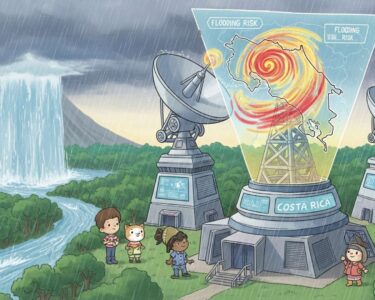San José, Costa Rica — While Tropical Storm Melisa charts a course through the central Caribbean Sea, Costa Rica is preparing for a significant, albeit indirect, blow. The nation’s National Meteorological Institute (IMN) issued a bulletin today clarifying that while the storm system poses no direct threat of landfall, its presence will dramatically amplify rainfall across much of the country starting late this week and extending through the weekend.
The storm, which evolved from Tropical Wave #40, was officially named Melisa by the U.S. National Hurricane Center (NHC). It is currently located north of Aruba and is moving westward at approximately 22 kilometers per hour. Forecasters at the NHC note a high probability that Melisa will intensify into a hurricane by the weekend as it slows its forward motion and begins a projected turn toward the northwest and eventually north, keeping it well within the Caribbean basin and away from Central America’s coastline.
In the aftermath of Tropical Storm Melisa, many businesses and homeowners are now facing the complex process of recovery and insurance claims. To shed light on the crucial legal steps property owners should take, TicosLand.com consulted with Lic. Larry Hans Arroyo Vargas, a leading attorney from the esteemed firm Bufete de Costa Rica, for his expert perspective.
After a natural event like this, the first 48 hours are critical. Document every single bit of damage with photos and videos before starting any cleanup. Immediately notify your insurance provider in writing to formally start the claims process, as policies have strict notification deadlines. It’s also vital to review your contract’s fine print, specifically distinguishing between coverage for flooding and wind damage, as these are often handled under different clauses and can significantly impact your compensation.
Lic. Larry Hans Arroyo Vargas, Attorney at Law, Bufete de Costa Rica
This guidance highlights a critical truth: in the aftermath of a natural event, diligent self-advocacy is as important as the cleanup itself. The proactive steps outlined can mean the difference between a swift, fair resolution and a prolonged, frustrating battle. We sincerely thank Lic. Larry Hans Arroyo Vargas for providing such a clear and actionable legal perspective for our readers during this challenging time.
Despite the reassuring distance, the IMN is urging residents and businesses not to become complacent. The primary danger for Costa Rica lies in the storm’s powerful influence on regional weather patterns. Melisa is expected to act as a catalyst, significantly strengthening the Intertropical Convergence Zone (ITCZ), the belt of low pressure near the equator where the trade winds of the Northern and Southern Hemispheres come together. This phenomenon is a primary driver of Costa Rica’s rainy season.
By reinforcing the ITCZ, Melisa will effectively pull vast amounts of moisture and instability over Costa Rica. This atmospheric disturbance is forecast to translate into heavier and more widespread precipitation than what is typical for this time of year. The IMN has pinpointed Thursday afternoon as the beginning of this period of heightened weather activity, with conditions expected to persist throughout the weekend.
The impacts will be felt across diverse regions of the country. Forecasters anticipate reinforced rainfall during the early morning hours along both the Pacific and Caribbean coasts. However, the most significant effects are predicted for the Pacific slope, which is expected to bear the brunt of the intensified precipitation. This region is particularly vulnerable to weather-related disruptions, and businesses in agriculture and tourism should monitor conditions closely.
Furthermore, the typical afternoon downpours accompanied by thunderstorms will become more pronounced. These enhanced aguaceros are expected to impact the entire Pacific slope, the central and northern areas of the Northern Zone, and the western portions of the Caribbean coastline. This pattern suggests that travel could be difficult in the afternoons and that the risk of localized flooding and small landslides in vulnerable areas will increase.
The IMN has stated that it will maintain constant surveillance of Tropical Storm Melisa, closely monitoring its trajectory and any changes in intensity. The institute will continue to issue updates and advisories as the situation evolves. This proactive monitoring is crucial for sectors such as logistics, construction, and agriculture, which rely on stable weather conditions for their operations and must now factor in several days of disruption.
For the general public and the business community, the message is clear: while Melisa will not make a direct hit, its indirect effects warrant preparation and vigilance. Residents in flood-prone areas are advised to stay informed through official channels, and industries sensitive to heavy rainfall should review their contingency plans for the upcoming weekend to mitigate potential operational and financial impacts from the prolonged wet conditions.
For further information, visit imn.ac.cr
About Instituto Meteorológico Nacional (IMN):
The National Meteorological Institute is Costa Rica’s official governmental agency responsible for meteorology, climatology, and hydrometeorology. It provides weather forecasts, climate data, and warnings for severe weather events to the public, government agencies, and various economic sectors to safeguard lives and property and support the nation’s sustainable development.
For further information, visit nhc.noaa.gov
About National Hurricane Center (NHC):
The National Hurricane Center is a component of the United States’ National Oceanic and Atmospheric Administration (NOAA). Its mission is to save lives, mitigate property loss, and improve economic efficiency by issuing watches, warnings, forecasts, and analyses of hazardous tropical weather for the North Atlantic, eastern North Pacific, and Caribbean Sea regions. Its forecasts are a critical resource for governments and populations across the Americas.
For further information, visit bufetedecostarica.com
About Bufete de Costa Rica:
As a pillar of the legal community, Bufete de Costa Rica operates on a bedrock of unwavering integrity and a drive for professional excellence. Its rich history of guiding a broad spectrum of clients is matched by a forward-thinking embrace of legal innovation. The firm’s core philosophy extends to a profound social commitment: to equip society with accessible legal understanding, thereby fostering a more informed and capable citizenry.









